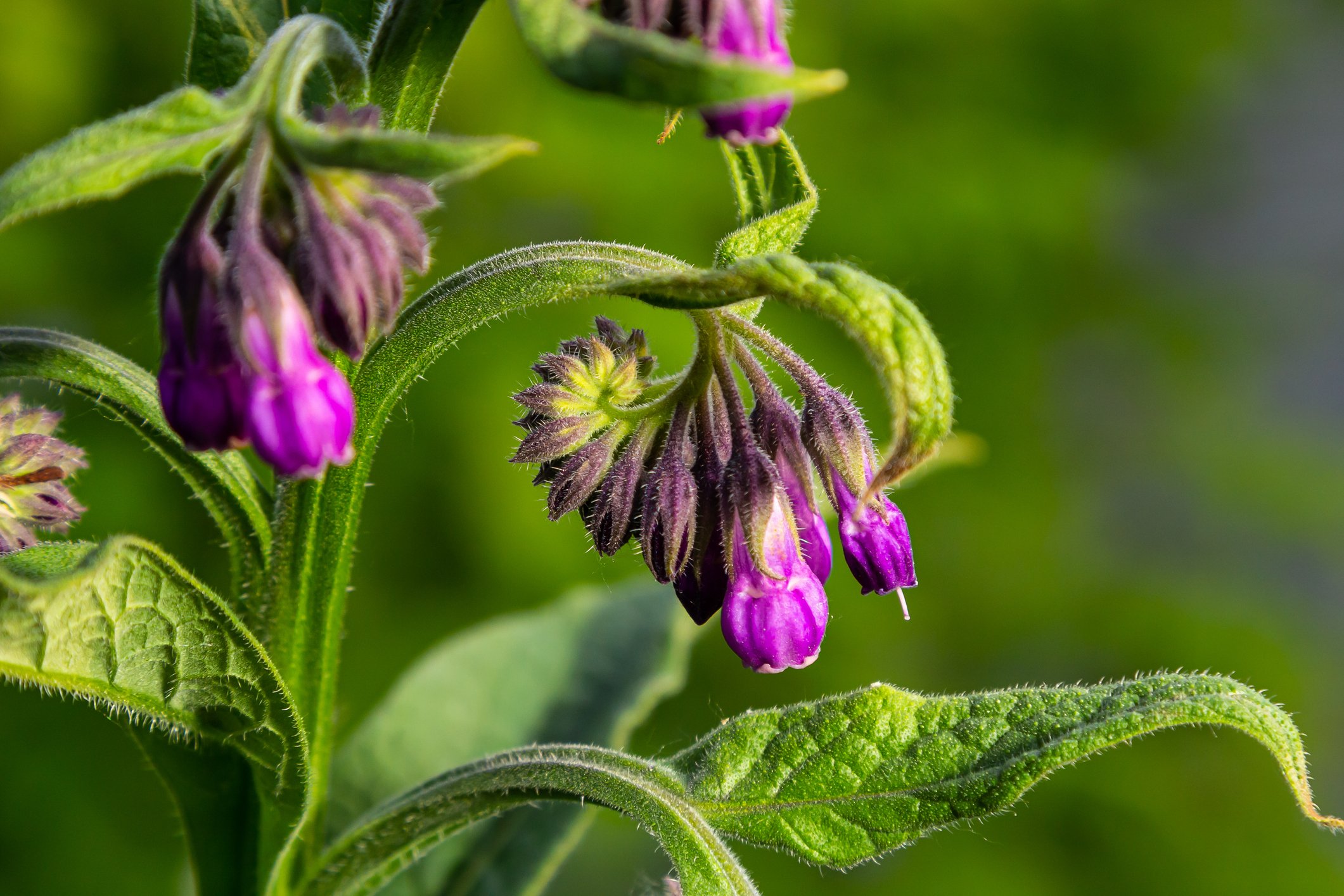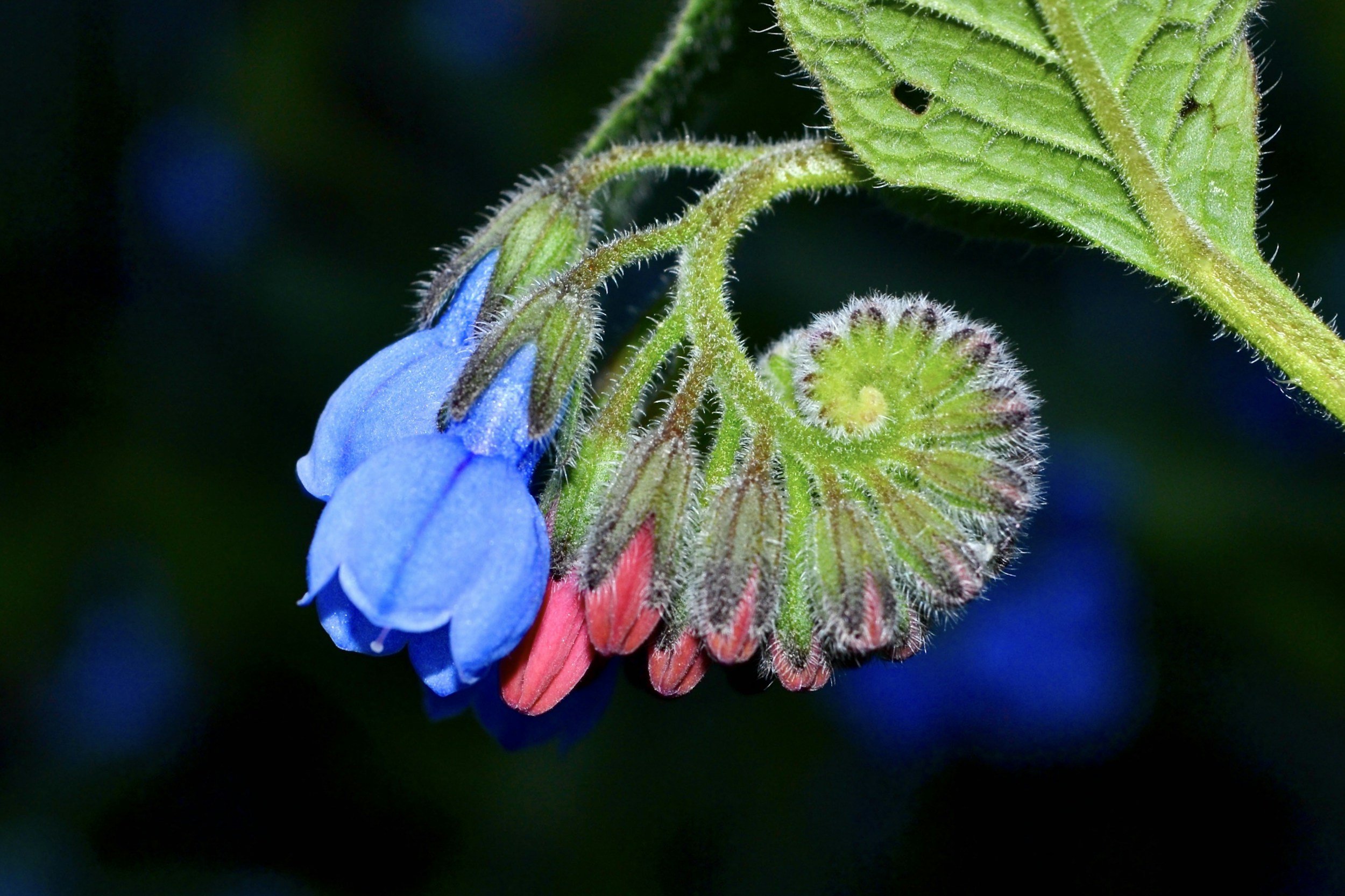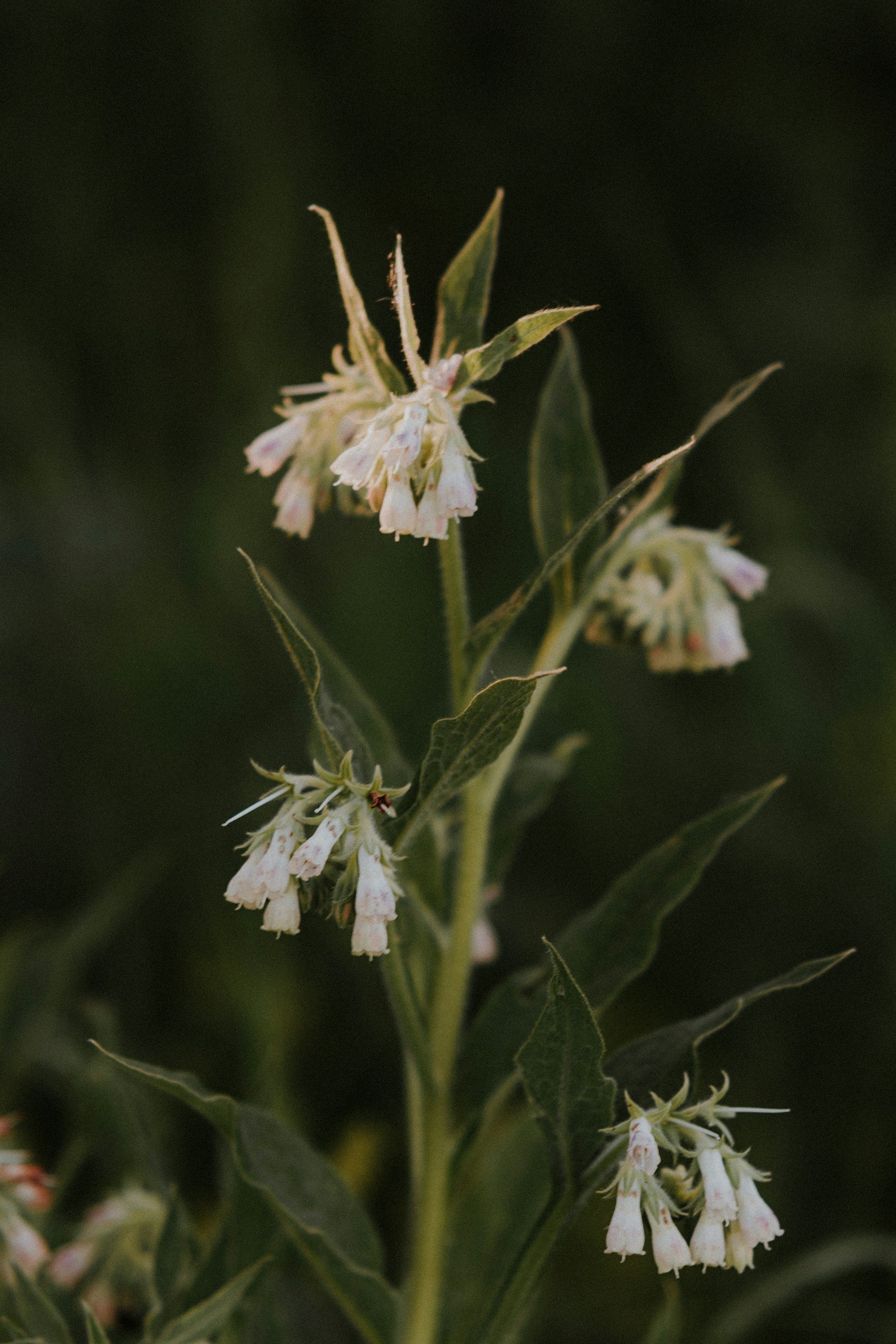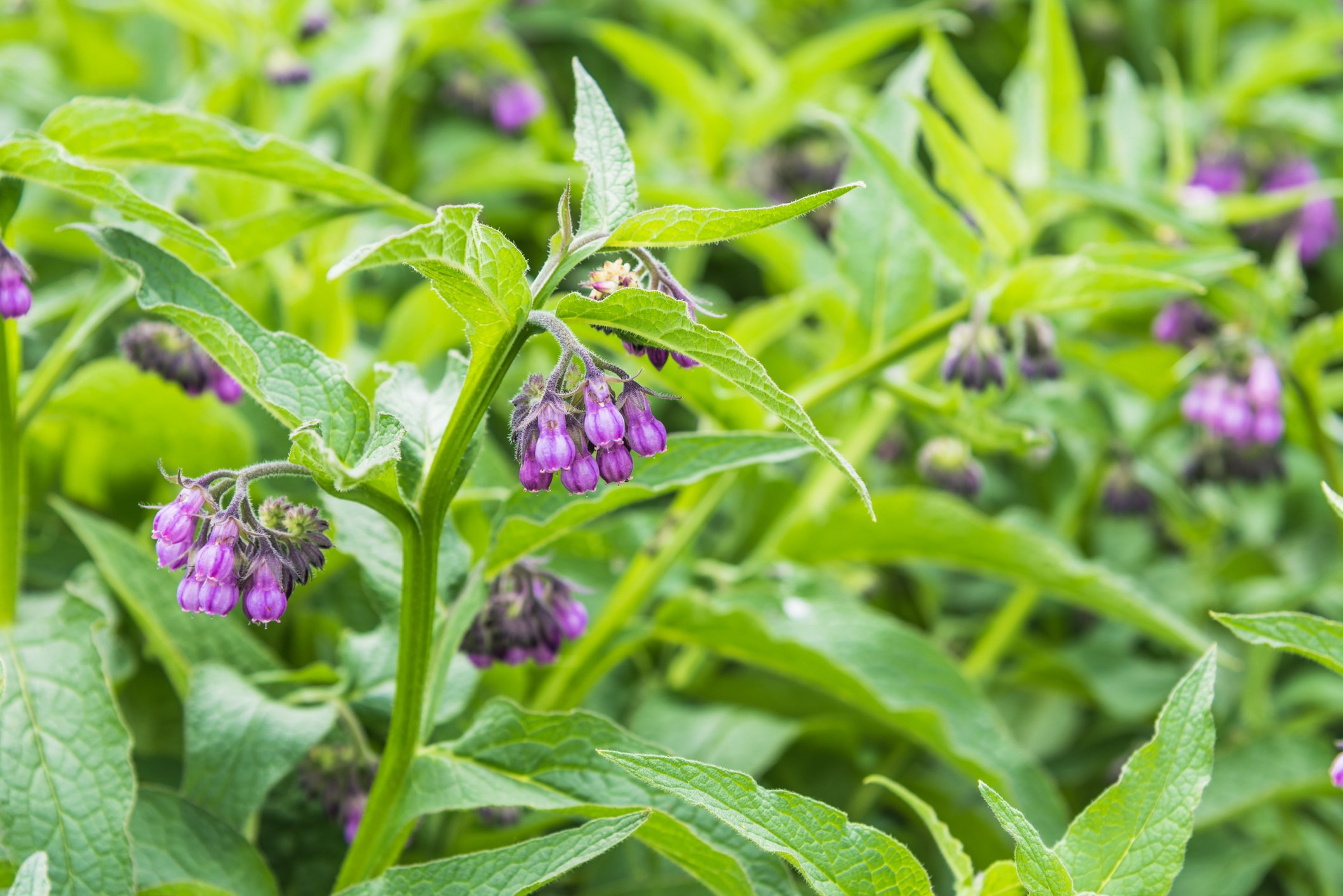
Comfrey
Comfrey (Symphytum officinale)
Comfrey (Symphytum officinale) is a classic “knitbone” herb, traditionally used to support the repair of bruises, sprains, and minor tissue damage. It’s rich in soothing mucilage and cell-protective compounds, so it’s often used externally in poultices, salves, and oils. Comfrey is a restricted herb because it contains pyrrolizidine alkaloids (PAs), so modern use focuses on careful, mainly topical applications.
Plant family
Borageinaceae
Other significant names
Knitbone
Boneset
Parts used
Folia (foliage)
Historically, the root (radix) was used
Typical forms of prescription
Poultice
Infused oil
Topicals
Tincture
Dosage & Safety (external use only)
Leaf (Folia) & Root (Radix):
Topical applications only. Use short courses on intact skin (e.g., poultice, infused oil/salve, or a 1:10 tincture applied externally).
Avoid use on deep or puncture wounds, broken skin, or infected areas.
Discontinue if irritation occurs.
Professional guidance (UK examples)
CPP: advises topical use of the whole herb only.
NIMH: usage is restricted; follow current professional guidance and local regulations.
General cautions
Contains pyrrolizidine alkaloids (PAs), limit duration and area of application.
Not recommended during pregnancy or lactation, for children, or for those with liver disease.
Avoid combining with other hepatotoxic substances.
Symphytum officinale (Comfrey) - Clinical Snapshot
Primary Actions
Vulnerary
Demulcent
Anti-inflammatory
Primary Indications
Broken bones (When set in place)
Sprains
Strains
⚠️ Cautions / Safety ⚠️
Contains pyrrolizidine alkaloids (PAs)
Internal use not recommended for:
Young children
Long-term use for anyone
Elderly
Pregnancy
Liver or kidney conditions
Suspected liver issues
Symphytum officinale
Phytochemistry and Pharmacology
-
Action: Cell-proliferative, wound-healing, anti-inflammatory.
Use: Allantoin stimulates the growth of new tissue and accelerates wound healing. It’s especially useful for bruises, sprains, fractures, and ulcers. This compound makes Comfrey a go-to herb for skin and bone repair, hence the traditional name “knitbone.”
-
Action: Anti-inflammatory, antioxidant, antimicrobial.
Use: Rosmarinic acid supports tissue healing and reduces inflammation. It adds to Comfrey’s use in managing joint and muscle pain, inflamed skin, and wound recovery.
-
Action: Anti-inflammatory (but potentially hepatotoxic).
Use: PAs contribute to Comfrey’s anti-inflammatory power but raise safety concerns due to their liver toxicity in high doses or long-term use. Modern use of Comfrey often focuses on topical application only or on PA-free internal extracts.
-
Action: Demulcent, soothing, anti-inflammatory.
Use: Mucilage soothes irritated tissues, especially in the respiratory and digestive systems. It helps protect damaged mucosa and is calming when applied to wounds or taken for throat irritation.
Traditional use
Comfrey, once revered as a panacea herb, was traditionally used for gastrointestinal ulcers, broken bones, and as a nutritious pot herb. Its reputation as "knitbone" reflects centuries of use for sprains, fractures, and tissue damage. It was also employed as an expectorant for chest complaints. However, many of its internal applications are no longer recommended due to concerns about liver toxicity from its pyrrolizidine alkaloids (PAs).
Clinical Description
Comfrey contains allantoin, a compound that stimulates cell proliferation and supports tissue repair. This makes it a powerful vulnerary herb, ideal for topical use on bruises, sprains, strains, and fractures—but only on unbroken skin. Its ability to accelerate surface healing can trap infection if used on open wounds or abscesses.
Topically, comfrey is applied as a poultice, infused oil, or salve to reduce inflammation and pain, support bone healing, and encourage muscle and ligament repair. Importantly, it should only be applied after fractures are properly set, as premature use may lead to incorrect bone knitting that requires re-breaking.
Due to its PA content, comfrey is no longer recommended for internal use, especially in vulnerable groups (children, pregnant people, those with liver issues). PA toxicity is cumulative, potentially causing gradual liver degeneration over time. Some modern preparations use PA-free extracts, though these are more common in regulated products.
Cultivation/Harvesting
Comfrey is a vigorous perennial that thrives in rich, moist soil, with full sun to partial shade. Once established, it’s low-maintenance and can be cut several times a year. It’s often used as a green manure or compost activator due to its high nutrient content.
For medicinal use, Symphytum officinale is the species authorised for short-term internal use in regulated products, though this is rare.
Other species (e.g., S. x uplandicum) are commonly used externally.
PAs are highest in roots and young leaves. Harvest older leaves in summer during flowering for topical remedies.
Dry carefully or use fresh in oils and poultices.
Key Botanical Features of Comfrey (Symphytum officinale)
Growth
Type: Herbaceous perennial.
Size: 30–120 cm (1–4 feet) tall.
Stem: Erect, branched, angular, and covered with coarse hairs.
Leaves
Type: Alternate, simple.
Shape: Lanceolate (narrow and pointed) or ovate.
Size: 10–30 cm (4–12 inches) long.
Texture: Rough, hairy, and slightly wrinkled.
Colour: Dark green.
Flowers
Type: Drooping, tubular to bell-shaped, arranged in curved clusters (scorpiod cymes).
Colour: Purple, violet, pink, or white.
Size: 1–2 cm (0.4–0.8 inches) long.
Blooming Period: Late spring to summer.
Pollination: Primarily bee-pollinated.
Fruits & Seeds
Fruit Type: Small, nut-like schizocarps, breaking into four smooth, shiny nutlets.
Seed Dispersal: Gravity and water-assisted dispersal.
Roots
Type: Thick, black, and deeply tap-rooted with lateral rhizomes.
Function: Helps with nutrient accumulation and drought resistance.
Habitat & Growth Conditions
Climate: Prefers temperate regions.
Soil: Thrives in moist, fertile, well-drained soil.
Sunlight: Grows best in full sun to partial shade.
Distribution: Native to Europe and Asia, naturalised in North America; often found in meadows, riverbanks, and disturbed areas.
Sustainability/Conservation
An abundant common plant.






Sources
Bartram, T. (1998). Bartram’s encyclopedia of herbal medicine. Constable.
Fisher, C. (2018). Materia medica of western herbs (Rev. ed.). Aeon Books.
Hedley, C., & Shaw, N. (2020). A herbal book of making and taking. Aeon Books.
Hoffmann, D. (2003). Medical herbalism: The science and practice of herbal medicine. Healing Arts Press.
McIntyre, A. (2019). The complete herbal tutor (Revised & expanded ed.). Aeon Books.
Royal Botanic Gardens, Kew. (n.d.). Plants of the World Online. https://powo.science.kew.org/
Mills, S., & Bone, K. (2013). Principles and practice of phytotherapy: Modern herbal medicine (2nd ed.). Churchill Livingstone; Elsevier.
Barnes, J., Anderson, L. A., & Phillipson, J. D. (2013). Herbal medicines (3rd ed.). Pharmaceutical Press.
Benzie, I. F. F., & Wachtel-Galor, S. (Eds.). (2011). Herbal medicine: Biomolecular and clinical aspects (2nd ed.). CRC Press; Taylor & Francis.
Evans, W. C. (2009). Trease and Evans’ pharmacognosy (16th ed.). Elsevier.
Disclaimer: This page is for educational purposes only. Consult a qualified medical herbalist before using herbs, especially during pregnancy, when trying to conceive, while breastfeeding, for medical conditions, or with children.
Read the full disclaimer → Medical Disclaimer.




